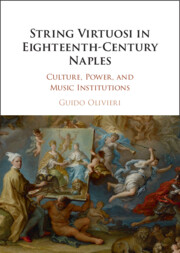Book contents
- String Virtuosi in Eighteenth-Century Naples
- String Virtuosi in Eighteenth-Century Naples
- Copyright page
- Dedication
- Contents
- Figures
- Tables
- Music Examples
- Acknowledgments
- Introduction
- 1 Music Institutions in Naples
- 2 The Formation of the Neapolitan String Virtuosi
- 3 Cello Virtuosi
- 4 Between Naples and Paris
- 5 Neapolitan Virtuosi in the Public Sphere
- 6 Neapolitan Instrumental Music under the Austrian Domination
- 7 Under the Wings of the Imperial Eagle
- Epilogue
- Bibliography
- Index
4 - Between Naples and Paris
The String Sonata in France
Published online by Cambridge University Press: 13 January 2024
- String Virtuosi in Eighteenth-Century Naples
- String Virtuosi in Eighteenth-Century Naples
- Copyright page
- Dedication
- Contents
- Figures
- Tables
- Music Examples
- Acknowledgments
- Introduction
- 1 Music Institutions in Naples
- 2 The Formation of the Neapolitan String Virtuosi
- 3 Cello Virtuosi
- 4 Between Naples and Paris
- 5 Neapolitan Virtuosi in the Public Sphere
- 6 Neapolitan Instrumental Music under the Austrian Domination
- 7 Under the Wings of the Imperial Eagle
- Epilogue
- Bibliography
- Index
Summary
The advent of the Bourbon dynasty in 1702 interrupted almost two centuries of Spanish dominion in Naples and opened up channels of artistic exchange between Naples and Paris. Arcangelo Corelli’s visit to Naples to celebrate the new king, Philip V, albeit allegedly ill fated, attests to the significance of the Neapolitan instrumental tradition and emblematically marks the start of the migration of Neapolitan musicians throughout Europe. The string virtuosi trained in the Neapolitan conservatories were the first players to familiarize French audiences with advanced Italian performance practices and had a crucial role in the dissemination of the Italian sonata in France. The initial resistance to the “eccentric” performances of these virtuosi, attested in the chronicles of the time, sparked debates on the respective merits of French and Italian music. Italian music became the expression of a new aesthetic and received the support of powerful aristocratic families and prominent members of the emerging French bourgeoisie, eager to distinguish themselves from the old regime. The new aesthetic approach appears in full display in the collection of solo violin sonatas published in Paris in 1712 by Giovanni Antonio Piani. In the preface to his collection, Piani provides examples of the advanced performance practices carried out by the Neapolitan virtuosi.
Keywords
- Type
- Chapter
- Information
- String Virtuosi in Eighteenth-Century NaplesCulture, Power, and Music Institutions, pp. 121 - 145Publisher: Cambridge University PressPrint publication year: 2023

